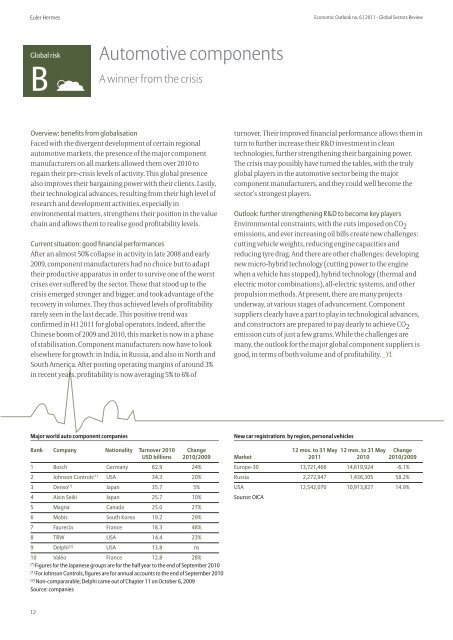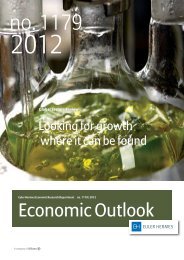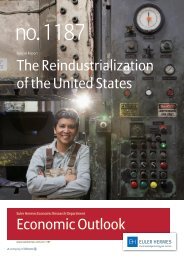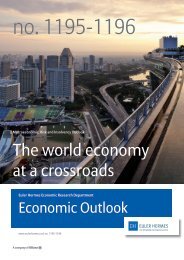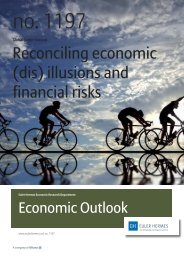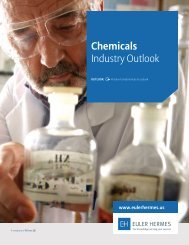You also want an ePaper? Increase the reach of your titles
YUMPU automatically turns print PDFs into web optimized ePapers that Google loves.
<strong>Euler</strong> <strong>Hermes</strong><br />
Economic Outlook no. 6 | 2011 - Global Sectors Review<br />
Global risk<br />
B <br />
Automotive compon<strong>en</strong>ts<br />
A winner from the crisis<br />
Overview: b<strong>en</strong>efits from globalisation<br />
Faced with the diverg<strong>en</strong>t developm<strong>en</strong>t of certain regional<br />
automotive markets, the pres<strong>en</strong>ce of the major compon<strong>en</strong>t<br />
manufacturers on all markets allowed them over 2010 to<br />
regain their pre-crisis levels of activity. This global pres<strong>en</strong>ce<br />
also improves their bargaining power with their cli<strong>en</strong>ts. Lastly,<br />
their technological advances, resulting from their high level of<br />
research and developm<strong>en</strong>t activities, especially in<br />
<strong>en</strong>vironm<strong>en</strong>tal matters, str<strong>en</strong>gth<strong>en</strong>s their position in the value<br />
chain and allows them to realise good profitability levels.<br />
Curr<strong>en</strong>t situation: good financial performances<br />
After an almost 50% collapse in activity in late 2008 and early<br />
2009, compon<strong>en</strong>t manufacturers had no choice but to adapt<br />
their productive apparatus in order to survive one of the worst<br />
crises ever suffered by the sector. Those that stood up to the<br />
crisis emerged stronger and bigger, and took advantage of the<br />
recovery in volumes. They thus achieved levels of profitability<br />
rarely se<strong>en</strong> in the last decade. This positive tr<strong>en</strong>d was<br />
confirmed in H1 2011 for global operators. Indeed, after the<br />
Chinese boom of 2009 and 2010, this market is now in a phase<br />
of stabilisation. Compon<strong>en</strong>t manufacturers now have to look<br />
elsewhere for growth: in India, in Russia, and also in North and<br />
South America. After posting operating margins of around 3%<br />
in rec<strong>en</strong>t years, profitability is now averaging 5% to 6% of<br />
turnover. Their improved financial performance allows them in<br />
turn to further increase their R&D investm<strong>en</strong>t in clean<br />
technologies, further str<strong>en</strong>gth<strong>en</strong>ing their bargaining power.<br />
The crisis may possibly have turned the tables, with the truly<br />
global players in the automotive sector being the major<br />
compon<strong>en</strong>t manufacturers, and they could well become the<br />
sector’s strongest players.<br />
Outlook: further str<strong>en</strong>gth<strong>en</strong>ing R&D to become key players<br />
Environm<strong>en</strong>tal constraints, with the cuts imposed on CO 2<br />
emissions, and ever increasing oil bills create new chall<strong>en</strong>ges:<br />
cutting vehicle weights, reducing <strong>en</strong>gine capacities and<br />
reducing tyre drag. And there are other chall<strong>en</strong>ges: developing<br />
new micro-hybrid technology (cutting power to the <strong>en</strong>gine<br />
wh<strong>en</strong> a vehicle has stopped), hybrid technology (thermal and<br />
electric motor combinations), all-electric systems, and other<br />
propulsion methods. At pres<strong>en</strong>t, there are many projects<br />
underway, at various stages of advancem<strong>en</strong>t. Compon<strong>en</strong>t<br />
suppliers clearly have a part to play in technological advances,<br />
and constructors are prepared to pay dearly to achieve CO 2<br />
emission cuts of just a few grams. While the chall<strong>en</strong>ges are<br />
many, the outlook for the major global compon<strong>en</strong>t suppliers is<br />
good, in terms of both volume and of profitability. _YL<br />
Major world auto compon<strong>en</strong>t companies<br />
Rank Company Nationality Turnover 2010 Change<br />
USD billions 2010/2009<br />
1 Bosch Germany 62.9 24%<br />
2 Johnson Controls (1) USA 34.3 20%<br />
3 D<strong>en</strong>so (*) Japan 35.7 5%<br />
4 Aisin Seiki Japan 25.7 10%<br />
5 Magna Canada 25.0 27%<br />
6 Mobis South Korea 19.2 29%<br />
7 Faurecia France 18.3 48%<br />
8 TRW USA 14.4 23%<br />
9 Delphi (2) USA 13.8 ns<br />
10 Valéo France 12.8 28%<br />
(*)<br />
Figures for the Japanese groups are for the half year to the <strong>en</strong>d of September 2010<br />
(1)<br />
For Johnson Controls, figures are for annual accounts to the <strong>en</strong>d of September 2010<br />
(2)<br />
Non-compararable; Delphi came out of Chapter 11 on October 6, 2009<br />
Source: companies<br />
New car registrations by region, personal vehicles<br />
12 mos. to 31 May 12 mos. to 31 May Change<br />
Market 2011 2010 2010/2009<br />
Europe-30 13,721,466 14,619,924 -6.1%<br />
Russia 2,272,947 1,436,305 58.2%<br />
USA 12,542,070 10,913,827 14.9%<br />
Source: OICA<br />
12


